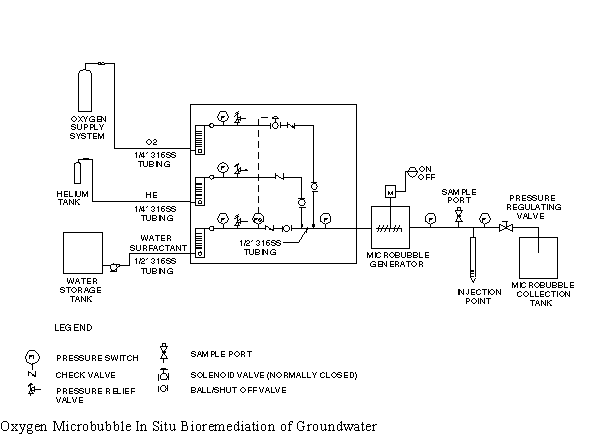
(Oxygen Microbubble In Situ Bioremediation)
The use of in situ bioremediation on contaminated soils and groundwater is becoming more widespread and accepted; however, one of the difficulties with in situ bioremediation is the limitations of oxygen delivery to the microflora for the degradation of the target contaminant. Oxygen microbubble technology may be effective in overcoming this limitation.
The oxygen microbubble technology (see figure below) uses a continuously generated stream of oxygen and water solution containing low concentrations of a surfactant. A water stream containing about 200 milligrams per liter of surfactant is mixed with oxygen under pressure. The resulting oxygen and water mixture is pumped through a microbubble generator that produces a zone of high-energy mixing. The result is a 60 to 80 percent by volume dispersion of bubbles with a typical bubble diameter ranging from 50 to 100 microns. The microbubble dispersion is then pumped through an injection well into the treatment zone. The microbubbles deliver oxygen into the contaminated groundwater, providing an oxygen source for the biodegradation of the contaminant by the indigenous microflora.

The process has successfully treated groundwater contaminated with a number of organic compounds including volatile organic compounds, semivolatile organic compounds, and petroleum hydrocarbons.
The Oxygen Microbubble In Situ Bioremediation process was accepted into the Emerging Technology Program in summer 1992. This process is being evaluated at a jet fuel spill site at Tyndall Air Force Base in Panama City, Florida.
The overall objective of this project is to evaluate the in situ application of the oxygen microbubble technology for bioremedation. The goals are to determine the subsurface oxygen transfer to the groundwater, retention of the microbubble in the soil matrix, and the biodegradation of the petroleum hydrocarbons present in the soil and groundwater.
A pilot test was performed at the site in 1995. The objective of this test
was to determine the rate at which generated microbubbles could be injected
into the surficial aquifer at the site. In addition, changes that occurred
in the microbubbles and the aquifer during injection were monitored. Parameters
that were monitored included the following:
The pilot test verified that microbubbles can be injected into a shallow aquifer consisting of unconsolidated, fine-grained sediments. The study also verified that aquifer characteristics allowed the injection of the microbubble foam at rates of at least 1 gallon per minute (foam). Continued injection of foam after about 45 minutes resulted in coalescence of the foam based on pressure measurements. The microbubble foam was observed to be persistent in the aquifer for long periods of time. This testing supported the use of oxygen microbubbles as an oxygen delivery system for in situ bioremediation.
The next testing phase at the site began in fall 1996. During this test, multiple injection points will be used to determine the maximum rate of foam injection while maintaining foam stability. Oxygen will be used as the gas for microbubble production. The rentention of oxygen microbubbles will be compared to sparged air to determine oxygen delivery efficiency.
EPA PROJECT MANAGER:
Ronald Lewis
U.S. EPA
National Risk Management Research Laboratory
26 West Martin Luther King Drive
Cincinnati, OH 45268
513-569-7856
Fax: 513-569-7105
TECHNOLOGY DEVELOPER CONTACT:
Douglas Jerger
OHM Remediation Services Corporation
16406 U.S. Route 224 East
P.O. Box 551
Findlay, OH 45840
419-424-4932
Fax: 419-425-6031